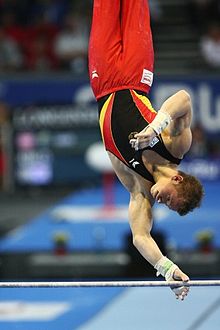Horizontal bar


Thehorizontal bar,also known as thehigh bar,is an apparatus used bymalegymnastsinartistic gymnastics.It traditionally consists of a cylindricalmetal(typicallysteel) bar that is rigidly held above and parallel to the floor by a system of cables and stiff vertical supports. Gymnasts typically wear suede leathergripswhile performing on the bar. Current elite-level competition uses a stainless steel core rail. The gymnastics elements performed on the horizontal bar are regulated by aCode of Points.A bar routine, which is a sequence of several bar skills, usually includesgiantswith various grips (overgrip, undergrip, dorsal grip, mixed grip), in-bar work, turns, release and regrasp skills, and a dismount. The horizontal bar is often considered one of the most exciting gymnastics events due to the power exhibited by gymnasts during giant swings and spectacular aerial releases and dismounts that often include multipleflipsor twists and, in some cases, airborne travel over the bar.
History
[edit]The horizontal bar was used byacrobatsinancient GreeceandRomeand on through theMiddle Ages.[1]It was introduced into gymnastics byJohann Christoph Friedrich GutsMuthsin his 1793 bookGymnastik für die Jugend,which in turn inspired further use and development byFriedrich Ludwig Jahnin 1811.[1][2]
Dimensions
[edit]The mechanical dimensions of the horizontal bar apparatus are specified inFIG'sApparatus Normsbrochure:[3]
- Height: 278 cm (109 in) (including about 30 cm (12 in) landing mats)
- Length: 240 cm (94 in)
- Diameter of the bar: 2.8 cm (1.1 in)
Grips
[edit]This sectionmay beconfusing or unclearto readers.(August 2012) |
The manner in which the horizontal bar is grasped by a gymnast is called thegrip(not to be confused with the suede leather grips that are worn on the hands). Each grip is commonly used for a particular set of skills. When gymnasts compete on the horizontal bar they are often required by theCode of Pointsto use specific grips.
- Theoverhand grip,orregular grip,is the standard grip used for the horizontal bar. On the overhand grip the hands circle the bar with the backs of the hands facing the gymnast.[4]
- Adorsal grip(also known as the dorsal hang) is an overhand grip employed while the gymnast's legs pass through the arms into a "skin the cat" position.[5]The overhand grip is used in giant swings, and the dorsal grip in German Giant Swings.[6]
- Thereverse gripandunderhand grip,is the opposite of the overhand grip. The palms of the hands face the gymnast. It is similar to the grip used in chin-ups. Forward giant swings are among the skills that use this grip.
- Theelgripis also anunderhand grip,In anelgriporL-Gripor eagle grip a gymnasts hands are turned 180 degrees outward from an over grip. Thumbs are turned out, but in the opposite direction of an undergrip. This position requires flexible shoulders to swing comfortably.
- Themixed gripis a combination of the overhand and underhand grips with one hand in each position. This grip can be used to gain more height on release skills.[7]
-
Mixed grip
-
Overhand grip
Routines
[edit]Under theFIG Code of Pointsfor men's artistic gymnastics, horizontal bar routines are dynamic presentations demonstrating "the full potential of the apparatus."[8]: 130 They consist of the fluid connection of swinging, turning, and flight elements performed without pauses near to and far from the bar in a variety of hand grips.[8]: 130
International level routines
[edit]A horizontal bar routine should contain at least one element from all element groups:[8]: 137
- I. Long hang swings with and without turns
- II. Flight elements
- III. In bar and Adler elements
- IV. Dismounts
Scoring and rules
[edit]Gymnasts receive deductions for lack of form and errors. Specific errors on horizontal bar include bent or separated legs, pauses, lowamplitudein flight elements, bent arms, regrips, elements not continuing in their intended direction, and deviations from the plane of movement.[8]: 141
References
[edit]- ^abButterworth, Horace (1902),The Horizontal Bar
- ^Goodbody, John (1982).The Illustrated History of Gymnastics.London: Stanley Paul & Co. pp.11–18.ISBN0-09-143350-9.
- ^"Apparatus Norms for gymnastics (2017)"(PDF).International Federation of Gymnastics (FIG).2019-07-20. Archived fromthe original(PDF)on 2019-07-20.Retrieved2019-07-20.
- ^Bill Sands and Mike Conklin,Everybody's Gymnastics Book,(New York: Charles Scribner's Sons, 1966), 42.
- ^Sands and Conklin, 42.
- ^Newton C. Loken and Robert J. Willoughby,The Complete Book of Gymnastics,6th ed., (Englewood Cliffs, NJ: Prentice-Hall, Inc., 1977), 200.
- ^Mitchell, Debby; Davis, Barbara; Lopez, Raim (2002).Teaching Fundamental Gymnastics Skills.Human Kinetics. pp.237.ISBN9780736001243.
gymnastics horizontal bar mixed grip.
- ^abcd"MAG CoP 2022-2024"(PDF).FIG.Archived(PDF)from the original on 2021-05-12.Retrieved2021-08-26.


